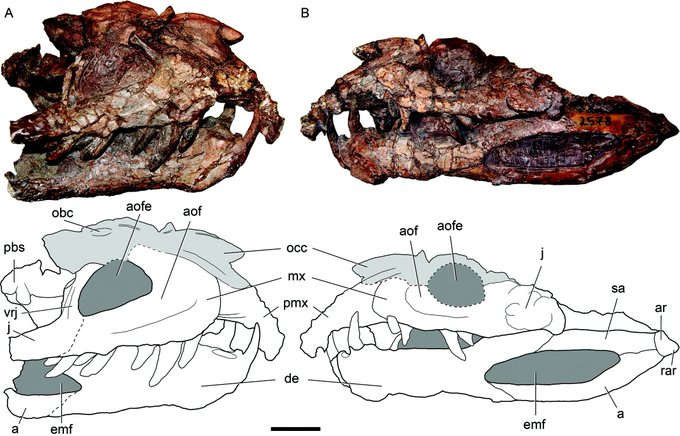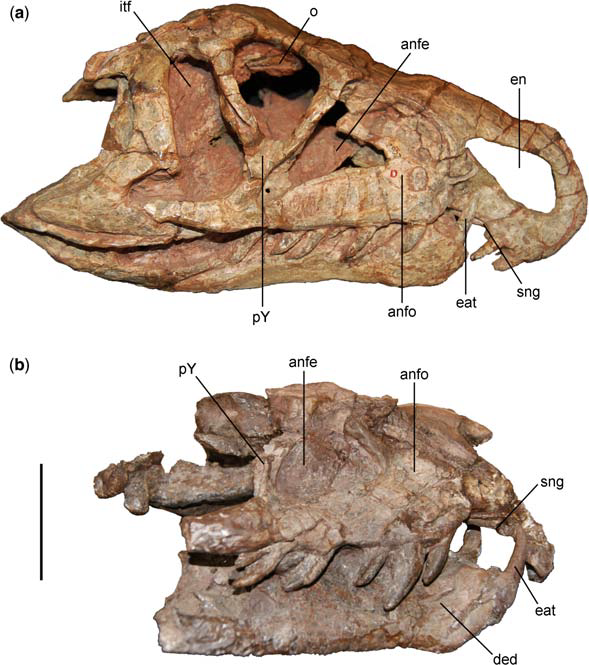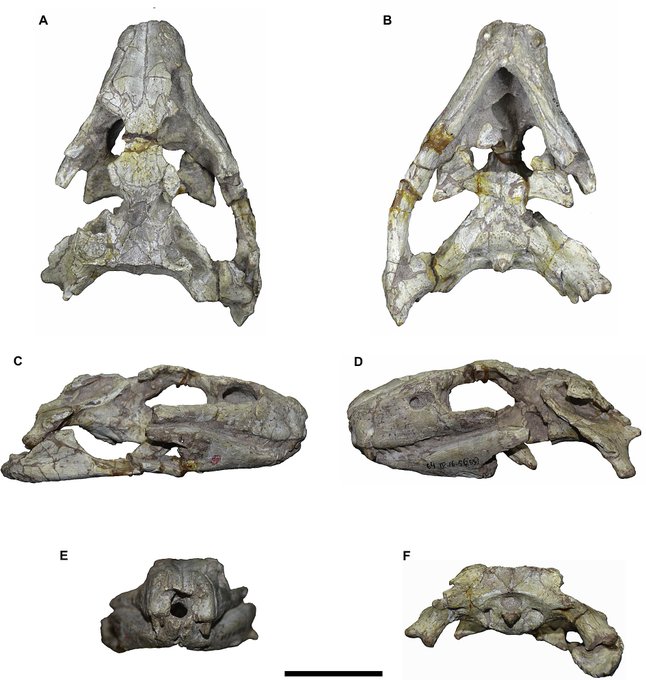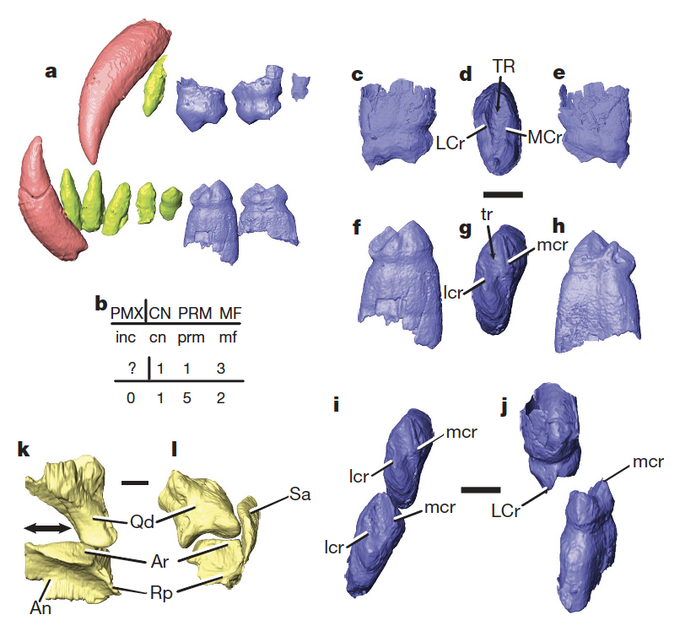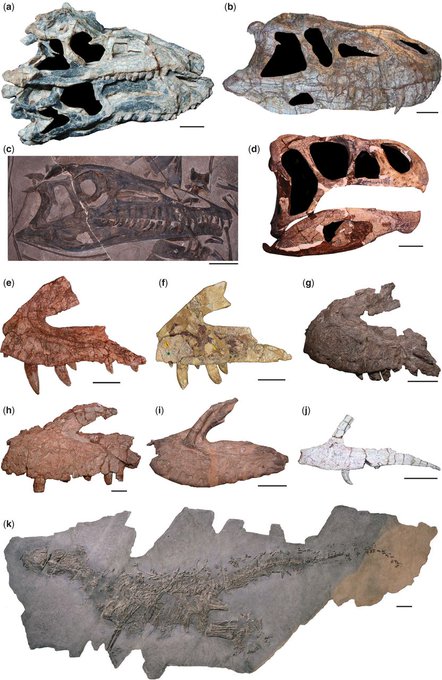AtoZcrocsのTwitterイラスト検索結果。 14 件
V is for Venaticosuchus, a very distant croc-relative from the Triassic of Argentina. It has an unusual overhanging upper jaw. #AtoZcrocs #Croctober #fossils
📸 von Baczko et al., 2014: https://t.co/XJiROqaTph
Yay #FossilFriday! N is for Neoaetosauroides, an #aetosaur from the L #Triassic of Argentina. Recently Taborda et al. used FEA to support possible zoophagy/omnivory, previously proposed by Desojo, & by von Backzo et al. https://t.co/6YtiXhaL55 #Croctober #AtoZCrocs #StemCroctober
Today’s #StemCroctober is Mystriosuchus Fraas 1896. These #phytosaurs, including M. westphali & M. planirostris, have a looooong slender snout & short squamosals. A 3rd one, M. steinbergeri, was added in 2019. It's from Austria & was marine! #Croctober #AtoZCrocs #StemCroctober
O is for Ornithosuchus, a distant croc-relative from the Triassic of Scotland. It may have been a facultative biped, meaning it could walk on two legs, but it could also walk on all fours. #AtoZcrocs #Croctober #fossils
📸 von Baczko and Ezcurra, 2016: https://t.co/eveQa8XJbX
N is for Notosuchus, a terrestrial crocodyliform with heterodont dentition from the Cretaceous of Argentina. It’s possible this croc was omnivorous or maybe even herbivorous. #AtoZcrocs #Croctober #fossils
📸 Barrios et al., 2018: https://t.co/dC3ZLsdixD
Today’s #Stemcroctober is Poposaurus gracilis Mehl 1915 from the Upper Triassic of the western US. Poposaurus has a remarkably similar body plan to dinosaurs, yet has hallmarks of all pseudosuchians. We know almost the full anatomy, minus parts of the skull #Croctober #AtoZCrocs
Pakasuchus had molar-like teeth that fit together to allow real chewing. It’s one of the most heterodont of the weird-toothed notosuchians, suggesting it might have been herbivorous. #FossilFriday #Croctober #AtoZcrocs #fossils
📸 O’Connor et al, 2010: https://t.co/rtNedrq2XD
Today’s #Stemcroctober is Nundasuchus songeaensis Nesbitt et al. 2014 a pseudosuchian from the Manda Beds of Tanzania. The phylogenetic position is poorly constrained, but largely because it lacks characters of the ‘classic’ pseudosuchian clades #Croctober #AtoZCrocs
Ogresuchus’ name comes from the speculation that it might have been eating young titanosaurs in the nesting ground where it was discovered, like the baby-eating ogres of legend. #fossils #AtoZcrocs #Croctober
📸 Sellés et al, 2020: https://t.co/mXkUXALJJQ
Today’s #Stemcroctober is Desmatosuchus spurensis Case 1921, an aetosaur from the southwest. It was a one of the largest with shoulders spikes measuring ~50 cm. The diet is his unknown, but it could have been the largest herbivore of NA in the L Triassic #Croctober #AtoZCrocs
Fasalosuchus was one of the biggest rauisuchians (maybe the biggest), at 8-10 meters long. It’s H in this figure, check out the scale bars to get an idea of the size difference. #Croctober #AtoZcrocs #fossils
📸 @VTechmeetsPaleo et al 2013: https://t.co/EqfrGZwkMQ
F is for Fasolasuchus (B in this pic), a very distant croc-relative from the Triassic of Argentina. It’s in a messy part of the #stemcroctober tree we sometimes lump together and call “Rauisuchians.” #Croctober #AtoZcrocs #fossils
📸 Lessner et al 2016: https://t.co/3k8BveHwLn
C is for Caipirasuchus, a crocodyliform from the Cretaceous of Brazil with particularly weird teeth. Most crocs are homodont (all their teeth look kind of the same), but Caipirasuchus is heterodont. #Croctober #AtoZcrocs #fossils
📸 @poldiego et al 2014: https://t.co/3aU3GapYAA
A is for Aegisuchus, a surfboard headed crocodyliform from the Cretaceous of Morocco with unusual ornamentation on the top of its head. #Croctober #AtoZcrocs #fossils
📸 #paleoart by Henry Tsai in @CrocHolliday and Gardner 2012: https://t.co/gWGZiVoC9u

